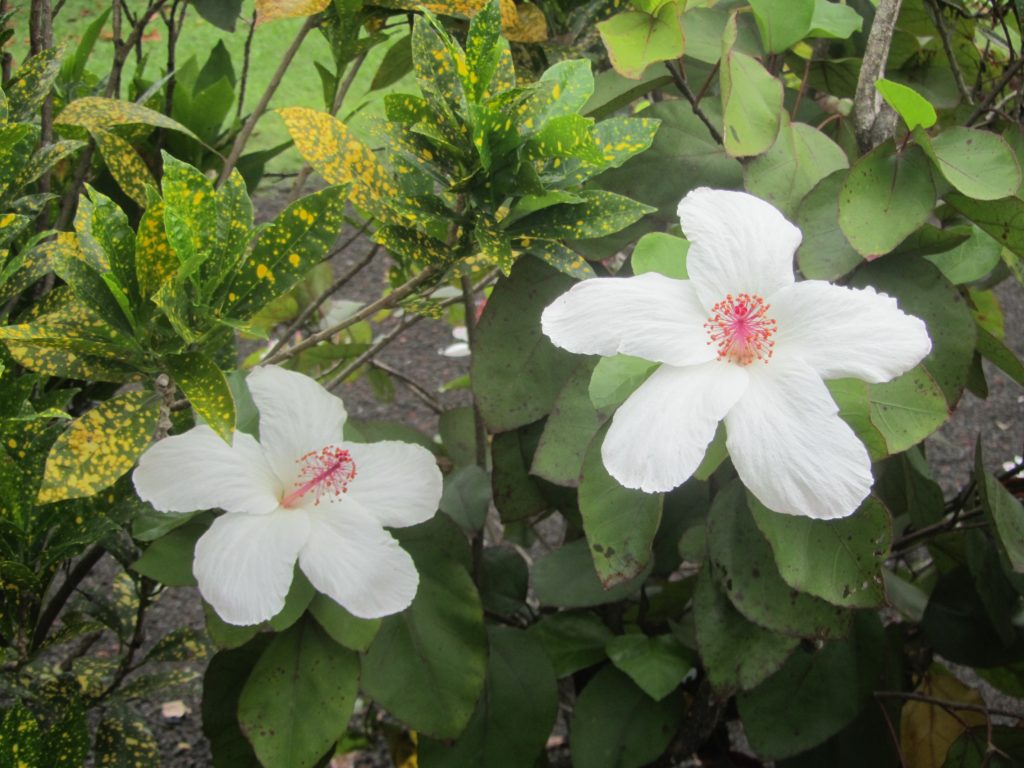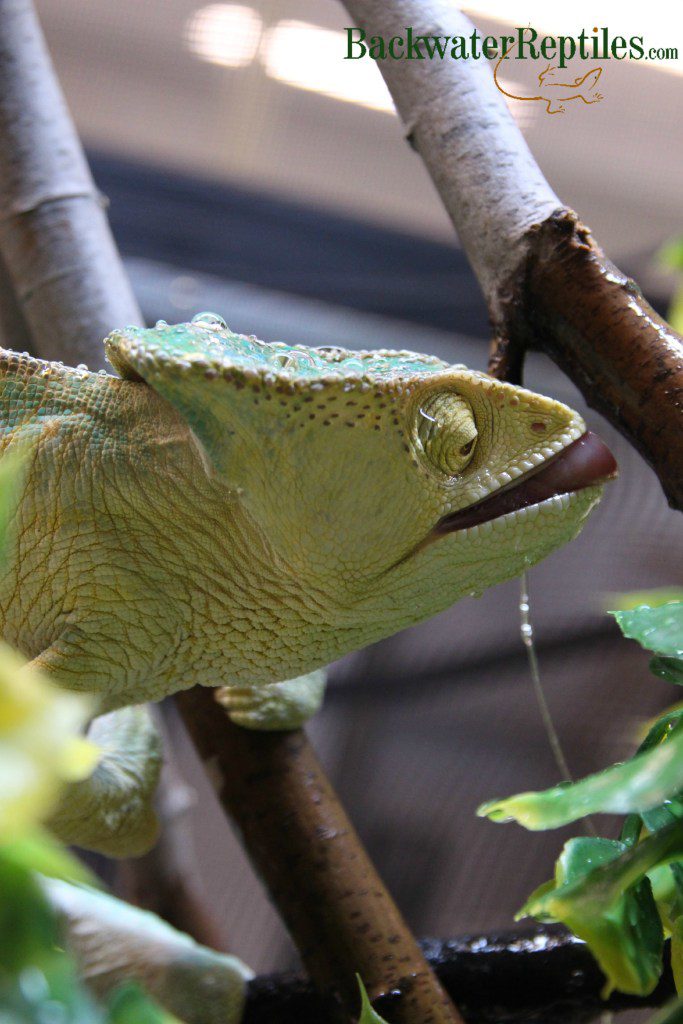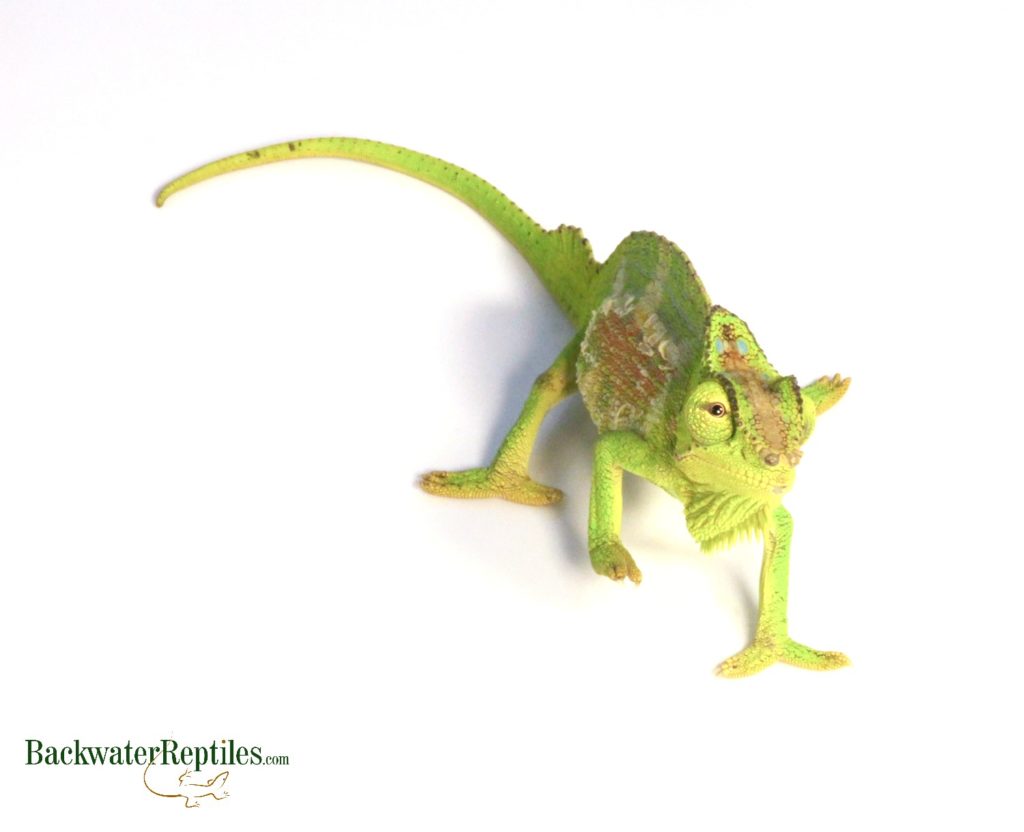We love chameleons at Backwater Reptiles. In fact, we specialize in these quirky, colorful, and always fascinating lizards. If you’re wondering how to setup a chameleon cage habitat or enclosure, you’ve come to the right place.
We’ve bred and hatched thousands of chameleons over the years, everything from common species to extremely rare. We’re experts on everything from breeding, feeding, and even hydrating these reptiles and we’re going to pass our knowledge on to you!
Many people are drawn to the bright complexions of chameleons and their ability to alter their color, but they don’t always take the time to research and find out the specific needs of their new pet lizard.
What might seem like common sense to experienced herpers is often like learning a foreign language to new reptile enthusiasts. They often need help getting started. That’s where this blog article comes in!
Not only will we provide written instructions on how to set up your pet chameleon’s enclosure, we’ll explain to you why things need to be done this way. And we’ve even thrown in a video tutorial for good measure!
So read on to find out how we set up our chameleon cages at Backwater Reptiles as well as learn some tips and tricks even if you are an experienced chameleon owner.
Overview of setting up your chameleon’s cage
Before you get into the nitty gritty specifics as detailed in writing below, we wanted to give you the chance to watch a video we made detailing how to set up the perfect enclosure for your pet chameleon. Watch the tutorial video and then read our FAQs for even more details!
What type of cage should I get for my chameleon?
Unlike many species of reptiles which will thrive in glass tanks, all chameleons (with the exception of the pygmy chameleon) should have a mesh or screen cage.
Although there are cages that have mixed glass and mesh walls, we recommend an enclosure that is completely screens with no glass walls to ensure your pet chameleon’s optimum health.
Are you wondering why your chameleon should have a mesh cage? The answer is simple really – ventilation. A glass cage prevents air from circulating properly and creates a stagnant environment within the chameleon’s home.
If the air doesn’t circulate properly, your chameleon can develop a respiratory infection due to stagnant, humid air. Once an infection takes hold, they’re not easy to eliminate.
If you’re wondering where to find a specialty chameleon cage, you can purchase them right on our website–the same ones we use so successfully. Each chameleon page has a supplies section if you scroll-down just a bit.
Many types and brands of chameleon cages exist, but we usually go for ones that give easy access to the animal with secure latches and swinging doors on the front. Some will also have sliding screen tops, although we prefer the front access kind.

Usually we also prefer mesh cages that have two separate swinging front doors – a larger top door for gaining access to your chameleon itself and a smaller, lower door. The lower door is opened to slide out your cage liner so you can wipe up dead insects and any feces that might collect.
Backwater Reptiles has a simple selection of cages and cage requirements that you can purchase at the same time you buy your pet chameleon. As mentioned, just scroll down a bit on any of our chameleon pages.
What size enclosure should my chameleon have?
Most chameleons are relatively small lizards with the exception of a few species such as Oustalets chameleons (Furcifer oustaleti), Parson’s chameleons (Calumma parsonii), and Mellers chameleons (Chamaeleo melleri). This means that you can house most species in small to medium-sized cages.
Babies and juveniles obviously don’t need as much space as their adult counterparts. In fact, we recommend smaller cages for babies because it can be hard for them to find their food source (i.e. catch the tiny crickets and fruit flies that they eat) in such a large cage.
However, there are certain instances where you can get one size cage and keep it for the entirety of your chameleon’s life.
Most common species of adult chameleons that are kept as pets such as Jackson’s chameleons (Chamaeleo jacksonii), Panther chameleons (Furcifer pardalis), and Veiled chameleons (Chamaeleo calyptratus) do just fine with a mid-size cage.
We recommend an enclosure that is eighteen inches deep by eighteen inches wide and thirty-six inches tall for sub-adults and adults. However, smaller cages can be used successfully.

Notice that the cage we recommended is more tall than it is wide? That’s because chameleons are arboreal species and they will spend most (if not all) of their time up in the branches and foliage you provide for them. You’ll very rarely, if ever, see your chameleon on the floor of the cage.
This means that height is far more important than floor space when keeping a chameleon’s life style in mind. More height means that the chameleon has more room to thermoregulate.
It can choose to be up high close to the heat source and UV lights to bask or it can descend further down into the enclosure to cool off.
What kind of accessories are safe to put inside my chameleon’s enclosure?
When it comes to decor and accessorizing your chameleon’s cage, we’re of the mindset that natural is beautiful. In other words, although it might not harm your chameleon to add cute little cage decorations, there certainly is no benefit to doing so.
We prefer our set ups to mimic the conditions of the chameleon’s natural habitat as closely as possible, which means plants and vines are our go-to accessories.
We recommend either artificial or living plants as your main cage decor. This is both practical and aesthetically pleasing. Chameleons needs lots of foliage to climb on as they are arboreal lizards and having plants inside the cage will satisfy this need.
Many cage set ups actually come with some artificial vines and foliage and these are perfectly acceptable options.
If you do choose to go with living plants, please make sure that you are not buying a toxic plant. Below is a list of a few species that we have used successfully in our set ups at Backwater Reptiles:
Hibiscus – This tropical plant has fairly large, green leaves and very gorgeous flowers when it blooms.

Ficus benjamina – This species of fig is commonly known as the weeping fig, Benjamin fig, or even simpler yet, the Ficus tree. Although this “plant” will eventually grow into a tree, if you purchase a young one at a hardware store, it will last you many years inside your chameleon’s enclosure.
Pothos Plant – Considered by many to be a classic house plant, the pothos plant is very easy to care for. It will grow quickly and “outward” unless you give it something to grab on to though, so we recommend a sturdy stick or branch to make it grow upwards within your chameleon’s cage.
Schefflera arboricola – We highly recommend this species if you want living plants in your chameleon cage. This species does very well under stress and doesn’t require much care to thrive.
The verdict – although we think living plants are more aesthetically pleasing, they can also add another layer of care to your chameleon set up. Not only will you have to care for a chameleon, but you’ll also have a plant to water and provide sunshine for.
Plastic foliage requires no additional care and is also easier to spot clean for feces and dead bugs.
What type of lighting and temperatures will my chameleon need?
Make sure that you provide a UVB light for your chameleon. It should sit atop the cage. You will also need to make sure that the foliage and climbing areas within the enclosure allow the chameleon to be within six inches of the UV light.
This distance is important because you don’t want to allow the chameleon to get too close to the light because it could unintentionally burn itself. But on the opposite side of the spectrum, if your chameleon can’t get close enough to the light, it won’t be able to properly absorb the rays and synthesize the vitamins that help it to develop strong bones.
At Backwater Reptiles, we prefer to use Zoo Med Reptisun 5.0 bulbs. We’ve had great success with these bulbs and we highly recommend them whenever people ask us. You can purchase the ones we use right on our website.
One quick note regarding all UV lights, whether they are used for a chameleon cage set up or for some other reptile – they need to be replaced every nine to twelve months. They lose their efficacy if you don’t replace them. We recommend changing sooner rather than later if you ever have doubts.
As far as temperature is concerned, we’ve found that room temperature tends to be just fine for most species of chameleons unless your ambient room temperature drops below seventy or above eighty-five degrees Fahrenheit.
You can provide a basking heat lamp in addition to a UV light. The ambient temperature around the basking area should be between one hundred and one hundred ten degrees Fahrenheit. You should invest in a reptile heat gun in order to monitor both your ambient cage temperature as well as your basking spot temperature.
Does my chameleon need a water dish?
The shortest answer to this question is no, your chameleon does not need a water dish.
Chameleons actually don’t drink water from a bowl. In fact, they will die of dehydration before drinking water from a dish. They simply won’t recognize it as a source of hydration.
How then do you get a chameleon to drink water and stay healthy and hydrated? The answer is simpler than you might think. All you need to do is regularly mist inside the cage or provide some sort of drip system on top of the cage.
Because we have many cages and many chameleons to care for, at Backwater Reptiles we have automatic misters called monsoons on top of all our chameleon enclosures. However, these are rather pricey misting systems and we only really recommend them if you have multiple animals and a very busy schedule.
If you just have a single chameleon or even a breeding pair living in a single enclosure, there are many ways to make sure your chameleon gets water. The first way is to simply manually use a spray bottle and mist the cage several times per day.
You’ll want to make sure that in addition to creating humidity, you are spritzing in areas to collect water droplets on the leaves.

You can also buy an inexpensive drip system from just about any pet store. These drip systems are usually tubs with a spout that allows you to control the intensity of the drip.
And if you’re real thrifty, you can even hydrate your chameleon using a small, plastic, disposable cup! All you have to do is poke a small hole in the bottom of the cup, fill it with water and set it in a place atop the mesh cage where it will drip onto leaves and create small pools of water for your chameleon to lap up.
So, we’ve learned that you can choose to hydrate your pet chameleon using several methods – manually misting, setting up an automatic mist system, or creating some sort of dripping apparatus.
However, one thing is definitely clear – a water dish is not necessary and your chameleon will not drink from it.
Conclusion – Setting up a chameleon cage
Chameleons make fantastic and rewarding pets. They are so fun to show off to friends and family and many can even be trained to eat from your hand!
Setting up a proper environment where they can thrive is paramount. We hope that this blog article has helped you out with your own chameleon’s set up, whether you’re brand new to keeping chameleons or an experienced herp enthusiast.




